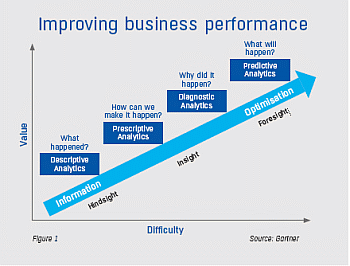Published on the 17/09/2013 | Written by Ian Bertram

Gartner’s Ian Bertram looks at the evidence on business intelligence and asks whether it’s worth the investment…
It’s widely recognised by business leaders that a change needs to happen: we need to treat information as an asset. But not all organisations treat information the same way or in fact use it the same way. Investment in business intelligence (BI) in the last decade has been seen as the way to make better use of this supposed ‘asset’.
Last year, Australian organisations spent more than A$436 million on BI software (including corporate performance management and analytics applications), an increase of 11.2% over 2011, and in New Zealand, spending grew 7.8 percent to NZ$68.7 million.
If you’re investing in BI today, what are you actually investing in? Are you investing in technology, are you investing in analytics, are you investing in organisational change, are you investing to help make a better decision, or are you investing in managing data more effectively?
Essentially it’s yes to all of these and more, but the extent of (and benefits from) your investment depends on the maturity of your organisation today and its willingness to bite the bullet on managing the information of tomorrow.
Organisations make hundreds if not thousands of decisions every day at different levels, with different degrees of impact, complexity, frequency and use. The only thing that’s constant is change, and BI and analytics represent a way of adapting to change. Identifying patterns, anticipating outcomes and responding proactively will be the basis of competition in the future.
Increasing analytics maturity
There are many styles of analytics needed for organisational decision making. It’s the combination of these styles that will increase the maturity of business analytics capabilities within an organisation.
Figure 1, outlines what we at Gartner call the analytics continuum, which explains the analytic styles from descriptive through to prescriptive analytics. Descriptive analytics is all those hundreds, if not thousands, of reports that we all generate but then never do anything with. I say that flippantly, but in many cases there’s a regulatory or compliance reason for having invested in the reports, so it’s being done for all the right reasons. It’s not money wasted, rather it’s a great foundation to build upon.

(Figure 1)
So far, 80 percent of analytics investments have been to produce historical/descriptive reports from information often aggregated in data warehouses and data marts. This is what has commonly been known as BI and investment will continue in this area. However, to get more value out of the data we manage, we then need to invest in diagnostic analytics such as interactive visualisation. This makes the data more consumable and usable.
Finally there are the more advanced styles of analytics such as predictive and prescriptive analytics. Predictive analytics uses technologies such as modelling, machine learning statistics and content analytics, while prescriptive analytics uses technologies such as decision/mathematical modelling, simulation and optimisation. These new styles have been pursued in silos within organisations today. That’s not necessarily a bad thing. The challenge is to harness the capabilities that are being developed and use those skills more broadly across the business.
There is a desire to shift capabilities towards the more advanced end of this analytic continuum, but skills will remain the biggest challenge for organisations. These additional capabilities often require new roles with additional quantitative, content and analytical skills, perhaps statistical analysts or data scientists.
Global trends
The global BI software market is highly fragmented with more than 50 vendors identified by Gartner with more than US$10 million in BI-software-related revenue. Despite this, it is fair to say that the market is dominated by five major players, led by SAP with 22.1% market share in 2012, followed by Oracle, IBM, SAS and Microsoft. Combined these market leaders dominate more than 70 percent of the BI software market globally.
There is a growing trend towards CIOs combining analytics with other technologies to create new capabilities, such as analytics plus supply chain for process management and improvement, analytics plus mobility for field sales and operations, and analytics plus social media for customer engagement and acquisition. New buying centres are also opening and expanding outside the IT department in line-of-business initiatives, and they are taking an increasingly large stake of the spending pie.
Two notable growth areas in the past 12-18 months are cloud-based buying and big data.
Cloud-based buying is showing substantial growth from a small base, especially for domainspecific analytic applications. Descriptive analytics has largely been completed for most big companies in traditional subject areas, such as finance and sales. As companies are now moving to more diagnostic use cases, growth opens up in numerous subject areas – such as HR, marketing, social and so on. New data sources, especially outside the firewall, have opened up for cloudbased vendors, which showed the most aggressive growth in 2012. However, cloud computing still accounts for a smaller portion of the BI market compared with other application markets.
Analytics plays squarely into the big data trend, where volume, velocity and variety aspects need to be taken into consideration. In that journey analytics pervade deeper in organisations, moving far outside the traditional ‘bread and butter’ BI domains and buying centres. But that also makes analytics bigger and more complex than we’ve been used to with traditional BI. Increased confusion around new hype terms and where the tangible benefits lie most likely contributed to a slowing of sales cycles in the BI market, while budget holders are trying to identify the tools and business value. In the medium term, we believe the much-hyped ‘big data’ will give way to what it has been all along – just ‘data’.
There is no doubt that organisations will continue to spend and earmark money for BI, despite constrained budgetary environments. What is becoming increasingly clear is that BI projects remain relatively shielded from budget cuts, while a healthy portion of any discretionary money will be available for upcoming analytic initiatives.
In short, organisations that are effective in adopting analytical capabilities and the integration between analytical capabilities and business processes are seeing lower costs and greater business impact from their investments.
 ABOUT IAN BERTRAM//
ABOUT IAN BERTRAM//
Ian Bertram is managing VP of Gartner’s analytics and business intelligence research team and head of research for Asia Pacific. Based in Sydney, he leads a global team of analysts who publish research and advise clients on analytics, business intelligence, information management, big data and performance management. Prior to joining Gartner, he was with IBM for 10 years.



























